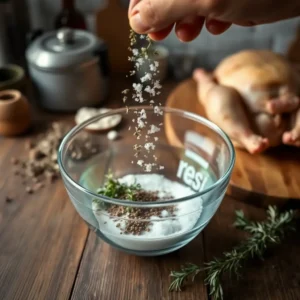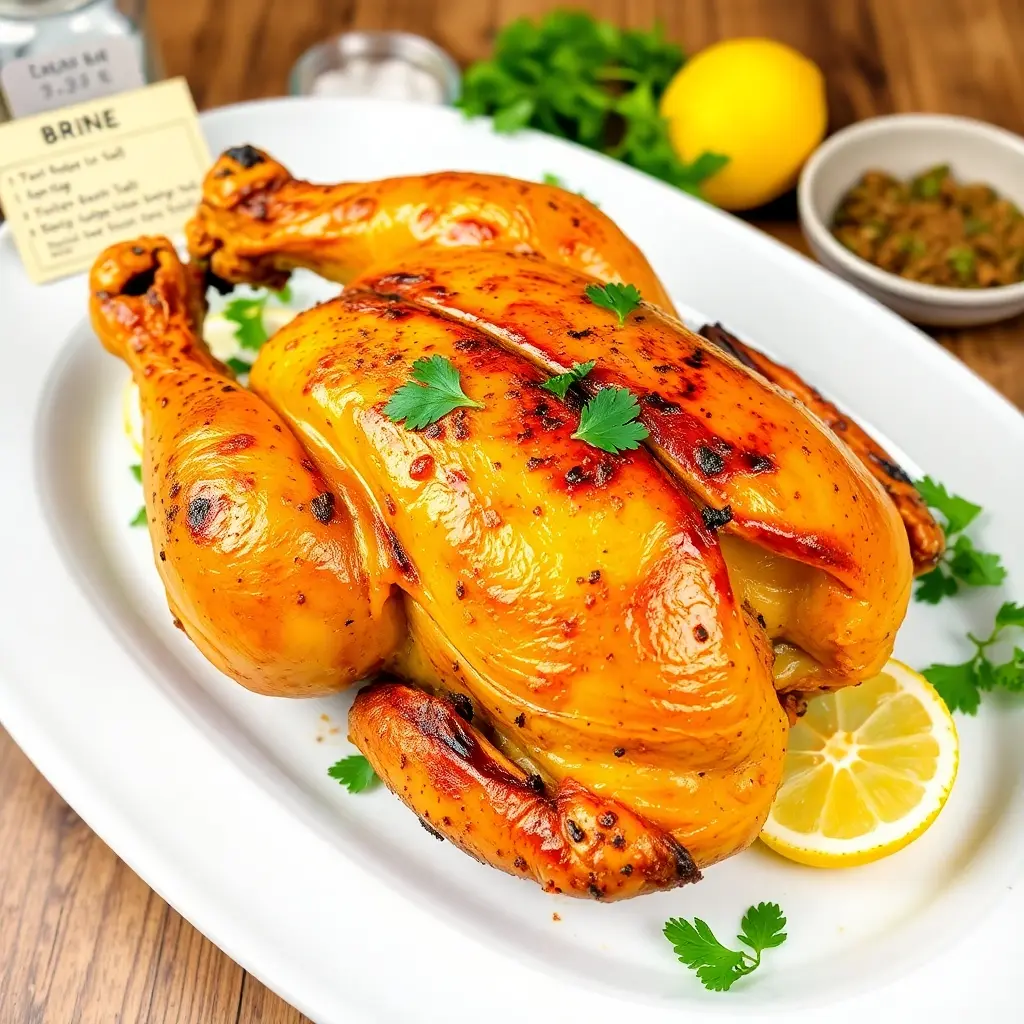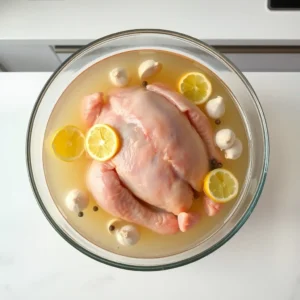Crafting the perfect chicken brine recipe is more than a culinary technique—it’s an art that transforms an ordinary meal into a flavorful masterpiece. Whether you’re roasting, grilling, or frying, brining enhances the juiciness and tenderness of your chicken while infusing it with irresistible flavors. This guide dives deep into the science, steps, and tips to master the ultimate brine, ensuring that your chicken is always juicy, tender, and packed with flavor. Let’s start by understanding the basics of what brining really is and why it’s a game-changer in the kitchen.
What Is a Chicken Brine Recipe?
The Basics of Brining Chicken
At its core, brining is the process of soaking chicken in a solution of salt and water, often enriched with herbs, spices, and other flavor-enhancing ingredients. This process not only adds moisture to the meat but also ensures that every bite bursts with flavor. The technique dates back centuries and has been a staple for chefs looking to elevate their dishes.
When you prepare a chicken brine recipe, you allow salt to break down proteins in the meat, creating a texture that locks in juices during cooking. If you’ve ever struggled with dry, tough chicken, brining is the solution you’ve been looking for.
History and Purpose of Brining in Cooking
Brining originated as a preservation method before refrigeration was available. Today, its purpose is entirely different. Modern brining focuses on improving the taste and texture of chicken. The process has evolved to include not just salt but also aromatics like garlic, onion, and thyme, which elevate the flavor profile of the dish.
From traditional recipes passed down through generations to innovative spins by today’s culinary experts, brining is a testament to how simple methods can yield extraordinary results. Ready to dig deeper?
Benefits of Brining for Chicken Recipes
- Enhances Juiciness and Flavor:
The moist chicken recipe you achieve through brining speaks for itself. By infusing water and seasonings, the chicken retains moisture better than unbrined poultry. - Science Behind Brining:
This isn’t just guesswork. Brining relies on osmosis and diffusion to draw flavors into the meat while simultaneously trapping moisture. Think of it as a culinary science experiment—with delicious results!
Brining is easy, effective, and essential for anyone aiming to create consistently tender and flavorful chicken. Once you try it, there’s no turning back.
Why Use a Chicken Brine?
Advantages of Using a Chicken Brine Recipe
When it comes to achieving the perfect chicken, brining is a technique that simply can’t be overlooked. Why? Because it ensures your chicken stays moist, tender, and packed with flavor, no matter how you choose to cook it. Without a brine, chicken can easily dry out, especially during grilling or roasting. However, brining acts as a safeguard against this common mishap.
- Keeps Chicken Tender and Moist:
The secret to tender chicken lies in the saltwater chicken soak. The salt solution breaks down muscle fibers, allowing the meat to retain moisture better than unbrined chicken. As a result, your chicken stays juicy, even after long cooking times. Isn’t that what every cook wants? - Infuses Herbs, Spices, and Aromatics:
Another benefit is flavor. Through brining, you’re not just adding moisture—you’re creating a flavor-packed experience. By customizing your chicken brine recipe with herbs like rosemary or spices like black pepper, you can make each dish unique. Why settle for bland when you can have extraordinary?
Different Uses of Brining in Chicken Recipes
Brining isn’t just for special occasions—it’s a versatile technique that works for everyday meals and gourmet feasts alike. Whether you’re planning a barbecue or prepping a weeknight dinner, brining can make all the difference.
- For Grilling, Roasting, and Frying:
No matter the cooking method, brining elevates your chicken. When grilling, it prevents the meat from drying out over high heat. For roasting, it helps achieve that perfect golden-brown exterior without sacrificing moistness inside. And for frying? Oh, the crispy coating paired with a juicy center is unbeatable! - Improves Cooking Consistency:
Let’s face it: cooking chicken perfectly every time can be tricky. Brining, however, evens the odds. It helps ensure that each piece—whether it’s a whole bird or smaller cuts—cooks evenly, avoiding the dreaded dry patch.
For those still on the fence, understanding the flexibility and results of brining might just make you a believer. After all, isn’t every bite worth it?
Essential Ingredients for the Perfect Chicken Brine

Must-Have Components of Chicken Brine
Creating the ideal chicken brine recipe requires just a few essential ingredients, but their impact on your dish is immense. With the right balance of salt, water, and complementary flavors, you can transform plain chicken into a culinary masterpiece. But what exactly do you need to get started?
- Salt – The Core of Any Brine Recipe:
At the heart of every brine is salt. It’s not just about seasoning; salt is the magic ingredient that tenderizes the meat and enhances flavor. For best results, use kosher salt or sea salt, as they dissolve evenly and avoid overpowering the dish. Without it, your brine wouldn’t work! - Water – The Brine’s Base:
Water is the foundation of any brine. It serves as the medium that carries salt, sugar, and spices into the chicken. Ensuring you have the right salt-to-water ratio is critical for achieving consistent results. Typically, one gallon of water to one cup of salt is a reliable starting point.
Add-Ons for Unique Flavors
While salt and water form the basics, adding extras like sugar, herbs, and aromatics can elevate your brine from simple to sensational. These ingredients allow you to customize the flavor to match your dish perfectly.
- Sugar for Sweetness:
Sugar is often overlooked but can be a game-changer. Not only does it balance the saltiness, but it also caramelizes during cooking, giving your chicken a subtle sweetness. Brown sugar, honey, or even maple syrup can be excellent choices. - Aromatics like Garlic, Onion, and Herbs:
For added depth, toss in fresh garlic cloves, sliced onions, or sprigs of thyme and rosemary. These ingredients infuse the brine with layers of flavor that penetrate the meat during the soaking process. - Optional Ingredients: Citrus, Peppercorns, or Vinegar:
Want to experiment? Try slices of lemon or orange for brightness, whole peppercorns for spice, or a splash of apple cider vinegar for tanginess. These tweaks can help tailor your brine to specific recipes or cuisines.
By combining these essential ingredients, you’re well on your way to mastering the moist chicken recipe you’ve always dreamed of. Ready to mix it all together? Let’s move on to the step-by-step process.
Step-by-Step Guide to Making a Chicken Brine
Preparing Your Ingredients
Making a perfect chicken brine recipe begins with proper preparation. This step sets the stage for a brine that’s not only effective but also packed with flavor.
- Measuring the Salt-to-Water Ratio:
To start, ensure you have the right ratio of salt to water, as this is the foundation of your brine. Generally, one gallon of water paired with one cup of kosher salt works well for most recipes. For smaller batches, scale accordingly. By doing so, you’ll avoid an overly salty brine that can overpower the chicken. - Choosing the Right Herbs and Spices:
Next, gather your seasonings. Herbs like thyme and rosemary are excellent for a classic brine, while spices such as black peppercorns or crushed red pepper can add depth and complexity. Want to experiment? Citrus zest or whole garlic cloves can provide a unique twist.
How to Brine Chicken Correctly
Now that your ingredients are ready, it’s time to create the brine. While it might seem straightforward, attention to detail here can significantly impact the final result.
- Mixing the Brine Solution:
Combine the water and salt in a large bowl or pot. Stir thoroughly until the salt dissolves completely—this ensures even seasoning throughout the brine. If you’re using sugar or aromatics, add them now so they can infuse as the salt dissolves. - Submerging Chicken in the Brine:
Place your chicken in a large, non-reactive container, ensuring it is fully submerged in the brine. For larger cuts like whole chickens, you may need to weigh it down with a plate to keep it entirely under the liquid. - Duration and Temperature Guidelines for Brining:
Timing matters! Smaller pieces like chicken breasts may only need one to two hours, while a whole chicken can soak for 12 to 24 hours. Keep the brine refrigerated throughout the process to maintain food safety. This step not only enhances flavor but also prevents spoilage.
By following these steps meticulously, you’ll end up with chicken that’s juicy, flavorful, and ready for your favorite cooking method. The next step? Pro tips to take your brining game to the next level.
Best Tips for Brining Chicken Like a Pro
Common Mistakes to Avoid
Although brining is relatively simple, certain missteps can undermine your efforts. Understanding these pitfalls ensures you get the best results every time.
- Over-brining or Under-brining:
One of the most common errors is leaving the chicken in the brine for too long or not long enough. Over-brining can result in overly salty chicken with a mushy texture, while under-brining won’t provide enough time for the solution to work its magic. Always follow the recommended brining times based on the size and cut of your chicken. - Not Rinsing the Chicken Post-Brine:
After brining, it’s essential to rinse the chicken under cold water to remove excess salt from the surface. Skipping this step can make the seasoning overly intense, especially if you’re adding a rub or marinade before cooking.
Enhancing Results
Want to elevate your brining technique? Incorporating these tips ensures your chicken comes out consistently delicious and full of flavor.
- Using Brine with Marinades:
A good brine doesn’t mean you can’t use marinades, too. In fact, brining first provides a moisture-locking base, while a marinade adds a top layer of flavor. For instance, after brining, a quick soak in a citrus-based marinade can infuse additional brightness into the chicken. - Resting Time Before Cooking:
Once you’ve brined your chicken and rinsed it, let it rest for about 20–30 minutes before cooking. This resting period helps the surface dry slightly, ensuring better browning when roasted or grilled. - Experimenting with Regional Spice Mixes:
Want to make your brine unique? Add spice blends inspired by regional cuisines. For a Mediterranean twist, try oregano and lemon. Craving bold flavors? Go for cumin and paprika for a smoky undertone. The possibilities are endless, and your creativity can truly shine!
By keeping these tips in mind, you’ll not only avoid common mistakes but also discover new ways to tailor brining to your personal tastes. And while perfecting your technique, don’t forget to consider the health aspects of brining, which we’ll cover next.
Nutritional Information and Considerations
Health Impacts of Brining Chicken
Brining, although a game-changer for flavor and texture, can affect the nutritional profile of your chicken. Knowing these details helps you make informed choices without sacrificing taste.
- Sodium Levels – Monitoring Intake:
While salt is the core of any chicken brine recipe, it’s essential to consider its impact on your sodium intake. During the brining process, some sodium is absorbed into the meat, which enhances flavor but can increase sodium levels. To address this, you can reduce the amount of salt in the brine or choose low-sodium alternatives. For health-conscious eaters, balancing flavor and nutrition is key. - How Sugar Affects Nutritional Content:
Many brine recipes include sugar to balance the saltiness and add a hint of sweetness. However, added sugar can increase the calorie count, especially if used in large amounts. If you’re mindful of sugar intake, consider natural sweeteners like honey or reduce the sugar content in your brine.
Alternative Brining Solutions
For those with dietary restrictions or preferences, there are several ways to modify brining recipes without compromising the final result.
- Low-Sodium Brines for Health-Conscious Cooking:
If reducing sodium is a priority, try substituting some of the salt with potassium chloride or using naturally salty ingredients like soy sauce in moderation. Low-sodium brines still tenderize and flavor the chicken but are gentler on your health. - Using Natural Sweeteners and Flavors:
Instead of refined sugar, opt for natural alternatives such as maple syrup, agave nectar, or fruit juices. These additions not only enhance sweetness but also introduce subtle flavor profiles that complement the chicken.
Nutritional Balance After Brining:
Keep in mind that rinsing the chicken post-brine can help remove surface salt and sugar, minimizing their impact on the final dish. Additionally, choosing cooking methods like grilling or baking reduces the need for added fats, making your meal even healthier.
By understanding these nutritional factors, you can enjoy the benefits of brining while staying aligned with your dietary goals. Finally, let’s tackle some common questions people have about brining chicken.
FAQs About Chicken Brine Recipe
How Long Should I Brine Chicken?
The duration of brining depends on the size and cut of the chicken. Smaller pieces, such as boneless breasts, only need about 1–2 hours to absorb the flavors effectively. Whole chickens, however, require more time—usually between 12 and 24 hours. Be cautious not to exceed these times, as over-brining can lead to a mushy texture or overly salty meat.
Can I Reuse Brine for Another Batch of Chicken?
While it might seem practical, reusing brine is not recommended due to food safety concerns. Once raw chicken has been submerged, the brine becomes a potential breeding ground for bacteria. To ensure safety, always prepare a fresh brine for each batch of chicken you plan to brine.
What’s the Best Salt-to-Water Ratio for Chicken Brine?
A common rule of thumb is to use 1 cup of kosher salt per gallon of water. This ratio ensures the brine is salty enough to tenderize and season the chicken without overwhelming the flavor. If you’re using table salt, reduce the amount slightly, as it’s finer and more concentrated than kosher salt.
Do I Need to Rinse Chicken After Brining?
Yes, rinsing is essential. After removing the chicken from the brine, rinse it thoroughly under cold water to eliminate any excess salt clinging to the surface. Skipping this step can result in an overly salty dish, especially if you’re seasoning or marinating the chicken before cooking.
Can I Brine Frozen Chicken?
Absolutely! You can brine frozen chicken, but remember to extend the brining time slightly to account for the thawing process. This method is particularly useful if you’re short on time and want to prepare frozen chicken without waiting for it to defrost completely.
What Happens If I Skip the Brine?
Skipping the brine means missing out on its moisture-retaining and flavor-enhancing benefits. Unbrined chicken often cooks up drier and less flavorful, especially in high-heat methods like grilling. Although seasoning the surface can add some taste, it simply doesn’t compare to the deep flavor infusion achieved through brining.
Conclusion
Mastering the art of the chicken brine recipe is a game-changer for anyone who loves cooking delicious, juicy, and flavorful chicken. From understanding the science behind brining to perfecting your salt-to-water ratios and customizing your brine with herbs and aromatics, this simple yet effective technique can elevate your dishes to new heights.
By avoiding common mistakes, experimenting with different ingredients, and paying attention to nutritional considerations, you can tailor your brine to suit your preferences and dietary needs. Whether you’re grilling, roasting, or frying, brining ensures that every bite of chicken is tender, moist, and packed with irresistible flavor.
So, what’s stopping you? Dive into your kitchen, gather your ingredients, and give this tried-and-true method a shot. With a little practice, you’ll never want to cook unbrined chicken again!


